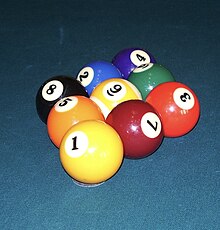
Back Девета топка Bulgarian Bola 9 Catalan Nine-ball Czech 9-Ball German Bola 9 Spanish Devetka Croatian 9-գնդակ Armenian ナインボール Japanese 나인볼 Korean 9-ball Dutch
 | |
| Highest governing body | World Pool-Billiard Association |
|---|---|
| First played | 1920s |
| Characteristics | |
| Contact | No |
| Team members | single competitors or doubles |
| Mixed-sex | Yes |
| Equipment | Cue sports equipment |
| Glossary | glossary of cue sports terms |
| Presence | |
| Country or region | Worldwide |
| World Games | 2001 |
Nine-ball (sometimes written 9-ball) is a discipline of the cue sport pool. The game's origins are traceable to the 1920s in the United States. It is played on a rectangular billiard table with pockets at each of the four corners and in the middle of each long side. Using a cue stick, players must strike the white cue ball to pocket nine colored billiard balls, hitting them in ascending numerical order. An individual game (or rack) is won by the player pocketing the 9-ball. Matches are usually played as a race to a set number of racks, with the player who reaches the set number winning the match.
The game is currently governed by the World Pool-Billiard Association (WPA), with multiple regional tours. The most prestigious nine-ball tournaments are the WPA World Nine-ball Championship and the U.S. Open Nine-ball Championships. Notable 9-Ball players in the game include Luther Lassiter, Buddy Hall, Efren Reyes, Earl Strickland and Shane Van Boening. The game is often associated with hustling and gambling, with tournaments often having a "buy-in" amount to become a participant. The sport has featured in popular culture, notably in the 1961 film The Hustler and its 1986 sequel The Color of Money.
Nine-ball has been played with varied rules, with games such as ten-ball, seven-ball and three-ball being derived from the game. While usually a singles sport, the game can be played in doubles, with players completing alternate shots. Examples of tournaments featuring doubles include the World Cup of Pool, World Team Championship and the Mosconi Cup.